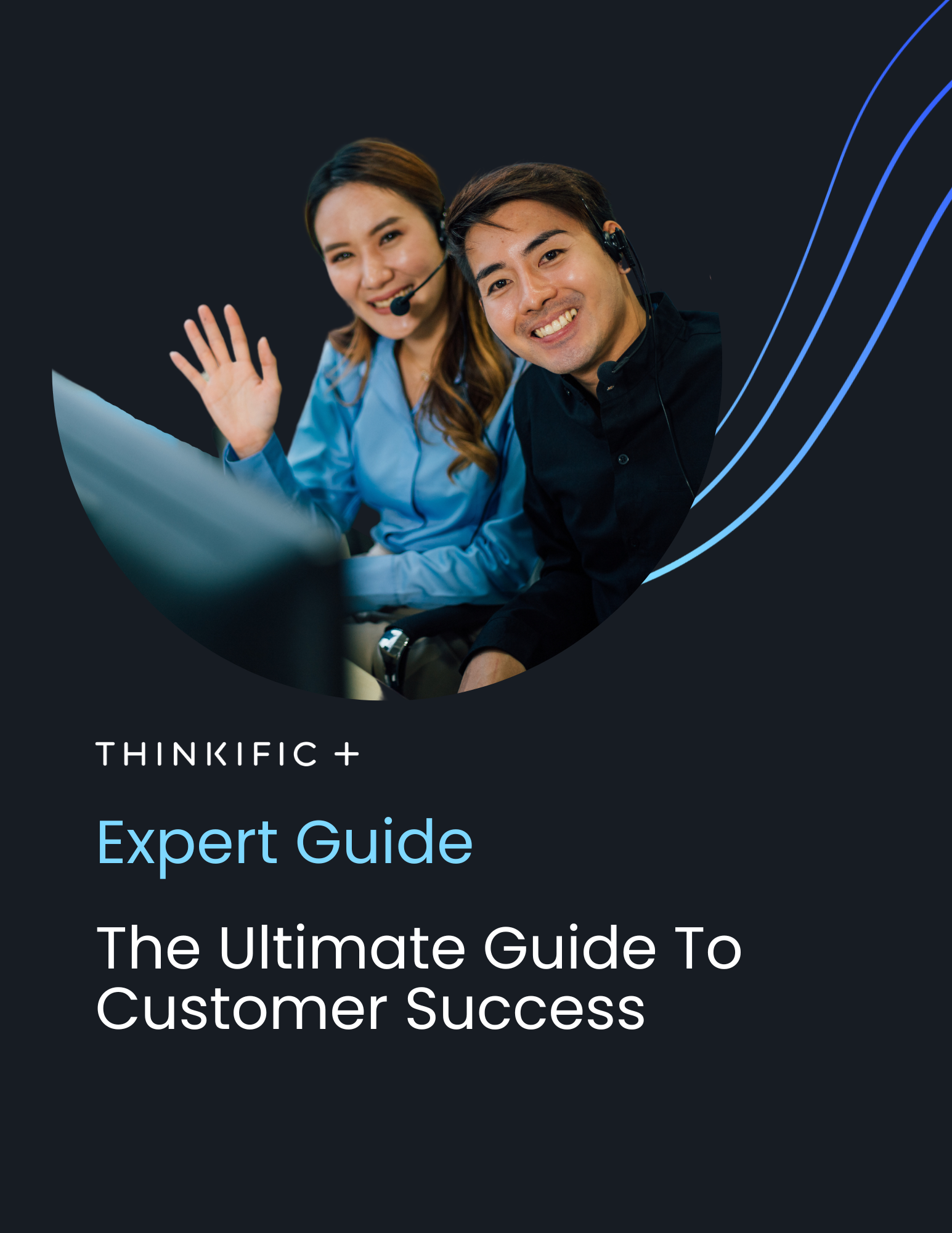Reduced churn, customer retention, product adoption, and customer success. These are some of the most common goals for organizations and entrepreneurs alike. The underlying theme for all of these is customer education.
The more complex your product, the greater the risk it will be misunderstood. If your customers don’t understand your product, they are unlikely to unlock its value and get buy-in from their team.
According to a Eureka report, product and service underperformance accounts for only 31.5% of customer churn. Overselling, customer service, onboarding, and poor relationship building make up 68.5%. In the U.S., avoidable customer churn is costing businesses over $136 billion a year.
Think about that for a moment… Only 3 in 10 customers are leaving due to product deficiencies and the majority of reasons for churn are completely within your control!
So, what is the solution?
The Technology Services Industry Association (TSIA) conducted a study last year on customer training and concluded that education could become a competitive differentiator. Trained customers renew 92% more often than untrained customers, and training increases self-sufficiency, reducing support requests by 87%.
In essence, customer education is the antidote to churn and it plays an influential role in overall customer success.
What is customer education?
Customer education is the process of teaching your customers about your product or service, it starts before they buy and continues throughout their customer journey. This process can take many forms, including online courses, blogs, or knowledge bases. Customer education both supports your customers in making an informed buying decision and enables them to get the most value out of the product after they decide to buy.
As a company or service provider, customer education is your opportunity to reinforce your brand’s value proposition while moving leads down the sales funnel. The more a lead learns about your product and sees its value, the more likely they will convert into an activated customer.
Why customer education is important
Online customer education provides an affordable option for growing companies to scale their customer success efforts without hiring more people.
Educating your customers will significantly increase your revenue and dramatically reduce your customer support costs. When customers are trained on your business tools and industry, they are much more likely to adopt your product and become power users. Their support tickets will decrease and their lifetime value will soar!
For example, Later, an Instagram scheduling tool, improved their customer retention by 320% after converting their onboarding webinar into an online course with Thinkific Plus.
By investing in customer education, businesses can attract qualified leads, improve product adoption, and drive customer success. Many companies also see a significant reduction in 1-on-1 support questions when they use online courses to train their customers upfront. This proactive 1-to-many training model allows companies to build educational explainer content once and use it to train their users at scale — which reduces customer frustration, churn, and expensive support costs.
By investing in customer education, businesses can attract qualified leads, improve product adoption, and drive customer success. Learn how to get started here! #customersuccess #onlinecourses #CX Click To TweetHow customer education impacts success in the customer journey
A true customer education strategy starts with the first interaction and continues throughout the customer journey. Whether that first touch is a blog post, an online course, or a person-to-person interaction, each point of contact shapes your customer’s relationship with your brand and product.
By using each of these interactions as an opportunity to educate your customers on the true value of your product, you’ll be able to align expectations, increase adoption, and reduce churn.
These customer interactions can be bucketed into three stages of the customer journey: 1) presale, 2) product adoption, and 3) continuous learning. As with any customer touchpoint, there are both opportunities and challenges faced within each stage which can have a lasting impact on customer success. Let’s take a look at each stage in detail.
Stage One: Presale
The presale stage is the first point of contact the customer will have with your product or service, which is largely driven by marketing efforts. At this stage, marketing works to produce content that informs and educates the customer on not only the value of your product or service but also on your industry as a whole (and how you compare against the competition).
The challenge: Providing unclear information or resources at the start can create the risk of attracting leads that are not the right fit for your product. This can ultimately result in customers who require extensive customer support, feel like they have been oversold, and increase your churn as the customer leaves after a few months.
Pro-tip #1: Create a customer journey map! Align your interactions with the customer journey of each customer type. Then, ensure that throughout every stage of that journey you understand who you are educating, what their role is, and how you can best meet their needs.
Stage Two: Product Adoption
After a sale closes, the product adoption phase of the journey begins.
This stage is usually led by your customer success management team. The goal here is to onboard customers, effectively build and manage the relationships, and reduce churn by meeting expectations established at the onset.
The challenge
When customers don’t have a full understanding of your product or service from the start (due to a lack of education), they need extra support, which means extra tickets for the customer success team. Instead of troubleshooting unique issues and accelerating your customer’s path to success, they instead spend hours and hours showing them how to use every part of the platform.
1 to 1 onboarding is simply not scalable. It’s obviously not cost-effective but it’s also not good for customer experience, as this high touch approach will lead to onboarding backlogs, implementation delays, slow responses to inquiries, and when you are eventually forced to reduce support, an increase in churn.
Pro-tip #2 Leverage online customer education to reach customers, at the right time and in an engaging format. Hootsuite, the world’s most widely used social media management platform, has done just that through Hootsuite Academy. The Academy began as a way to teach customers about the Hootsuite Dashboard but quickly evolved into educating customers on how to use social media generally. Their team understood that it was crucial to help people build knowledge and confidence about social media first before they could fully understand the value of their platform. Hootsuite’s Director of Inbound and Education , David Godsall agrees:
“Education is how we ensure our users are successful, and that’s how they become loyal Hootsuite customers.”
Stage Three: Ongoing Education
The final step of the customer journey is ongoing education – keeping your customers up to date with product or industry changes and to increase their abilities with and usage of the product.
In this stage, your customer support team is your first line of defense to customer inquiries. They are there to answer questions, resolve issues quickly, and explain new features. The goal is to provide quick support to customers and collect data to continue to improve your product or support documentation.
The challenge:
For customer support, a lack of customer understanding of the product means answering the same questions over and over again. The ticket volume can become unsustainable, leading to longer wait times and frustrated customers. If you don’t address these concerns, you could see increased turnover.
Pro-tip #3: Create proactive online courses based on customer data to address ongoing customer support and continuing education. 80% of the questions companies receive in this stage could be answered by 20% of the courses they are creating. Make your academy the first place they go to ask questions.
For example, Sendable, a social media management tool, put their most common customer inquiries into an academy and they’ve seen a huge decrease in the number of questions they were receiving through support.
Pro-tip #4: Repurpose customer education for onboarding new employees. You’re creating great customer support content, why not share it with your internal team and partners? Repurpose that customer education as much as possible and increase your return on your investment.
Struggling to reduce churn? These 6 steps will help you develop and launch your customer education strategy to do so! #customersuccess #onlinecourses #CX Click To TweetTakeaway: 6 Actionable Steps to Amplify customer Education and Increase Customer Success
Now that you have an understanding of the value of customer education and how it impacts your customers at every stage of their journey, it is time to start building your own process. The following six steps will help you develop and launch your customer education strategy.
- Map out your customer journey
Start by drawing out your customers’ journey. How do they learn about your company? Where do they first interact with your team? When do they make their buying decision? - Listen to your customers and record the data
Understand the questions that are being asked throughout their journey. Don’t create content that answers questions no one is asking. - Start with one course
It is easy to overthink your strategy when getting started. Begin with one course addressing your most common question and go from there. - Create courses around outcomes, not features
While your courses are meant to help your customers understand your product, they should be centered around helping your customers achieve success. Think about why they bought your product in the first place. What were their goals? How could your course help you get them closer to them? - Create interesting content
In stating the obvious, no one likes boring content. Utilize multiple lesson types, incorporate quizzes, and build a community that engages your customers and helps achieve mutual success. - Find the right customer education platform
Starting your search for a learning management system (LMS) can be overwhelming, especially if you’re looking to launch an online academy for the first time. Look for a platform that is easy to set up and maintain, that integrates with your existing software, and that is customizable for your brand needs. Thinkific Plus gives you an opportunity to get your hands dirty and try our software. Schedule a call here to try it for free.
Looking to increase Customer Success for your organization? Download your free Ultimate Customer Success Guide now.







